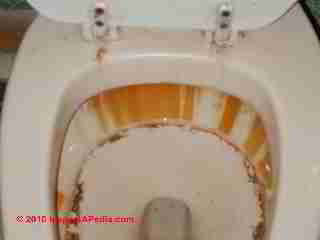 Slow-Flushing Toilet Repair Guide
Slow-Flushing Toilet Repair Guide
Diagnose & Repair Toilets
- POST a QUESTION or COMMENT about fixing slow-flushing toilets and johns or loos
Slow flushing toilet repairs:
Here we explain how to diagnose and repair toilets that flush too slowly or have a weak flush, sometimes backing up.
We explain how to diagnose and repair problems with toilets, leaks, flushes, odors, noises, running and wasted water.
Our page top photo shows ugly staining in a toilet bowl - strong evidence that this toilet has been running, wasting water, possibly flooding the septic system, and sometimes giving bad flush performance as well. Details are below.
InspectAPedia tolerates no conflicts of interest. We have no relationship with advertisers, products, or services discussed at this website.
- Daniel Friedman, Publisher/Editor/Author - See WHO ARE WE?
Toilet Flushes Poorly - Too Slowly, or Leaves Waste in the Bowl
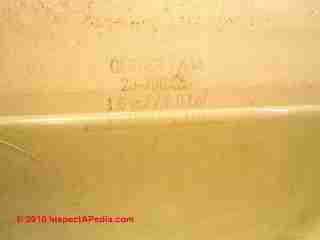
There are several other reasons why a toilet fails to flush properly besides a clogged drain.
Here we list each cause of toilet flushing difficulties and suggest how to diagnose and repair the condition.
Poor-flushing low-water-consumption toilets: Keep in mind that modern low water consumption toilets (ASME/ANSI A112.19.M) are designed to use 1.6 gallons (6 liters) per flush or less - a desirable step in reducing water consumption in buildings.
But with the lower total flush volume designed into the toilet, if the toilet fill and flush valves are not properly adjusted, these toilets may cause complaints of poor performance. Don't rush to change out a toilet that is not working satisfactorily. toilet flush control tune-up may be all that's needed.
Our photo (above) shows the water level in a modern low-flush toilet tank, sitting just a fraction above the fill line. This toilet has adequate water to flush properly, if it is properly vented and if its drain is not blocked.
If the toilet is totally blocked and not flushing, see Toilet Drain Clogged.
At PLUMBING DRAIN VENTS we explain the basics of proper plumbing vent piping and how errors cause trap siphonage, odors, and noises.
More details about plumbing drain line venting can be found at PLUMBING VENT CODES, DEFINITIONS, TYPES,
also PLUMBING VENT DEFECTS & NOISES and
at CLOGGED DRAIN DIAGNOSIS & REPAIR.
This sketch helps identify the toilet operating and repair parts we discuss in this article.
The Basics of How Toilets Work
While there have been improvements in toilet tank fill valves, flush valves, floats, and water savings, the design has remained about the same.
[Click to enlarge any image]
A flush lever moves an arm to lift a flapper valve or tank ball to permit water to rush into the toilet bowl below, washing away waste into the sewer pipe.
At the end of the flush cycle, a float arm, or a float moving on a vertical stalk (newer valves) drops to open a valve permitting the toilet tank to refill with water.
When the toilet tank water level reaches the proper level, the float closes the toilet tank fill valve.
Check for a Blocked Drain or Improper Venting
 If the toilet always flushes, but it empties too slowly, or empties incompletely
If the toilet always flushes, but it empties too slowly, or empties incompletely
- Blocked drain: the building drain/waste piping may be blocked or partly blocked. Try using a toilet plunger - don't give up too soon.
First see TOILET CLOG REPAIR, UN-BLOCK - a partial drain blockage will result in a slow toilet flush while a total drain blockage means the toilet will overflow when flushed.
To diagnose and fix a blocked drain also
see CLOGGED DRAIN DIAGNOSIS & REPAIR
and BLOCKED DRAIN REPAIR METHODS - Vent defects: the plumbing vent may be partly blocked. If a gurgling sound is heard at a sink or shower drain only when a nearby toilet is flushed, or at a sink or shower when a nearby tub is draining, we'd suspect that the building drain-vent system is inadequate.
- The toilet may not be properly vented. If the trap at the nearby bathroom sink is an "S" trap, there is a good chance that no plumbing vent was ever provided and it's an older building.
See PLUMBING VENT DEFECTS & NOISES - Low-Pressure CIstern by Design: a low-profile toilet may be installed (photo at above-left). Some low profile toilets use a very low toilet tank for aesthetic reasons. We have found that some of these models do not flush well unless the cistern volume is perfectly adjusted, the drain is working perfectly, the vent system is perfect, and no challenging waste deposits are in the toilet bowl.
A poor flush factor may be the lower water pressure afforded by low profile tanks that are not as high above the toilet bowl. The author's mother swapped out all of the low-profile toilets in her home because of dissatisfaction with the toilet's flush performance.
Check & Adjust the Toilet Cistern or Tank Fill Volume
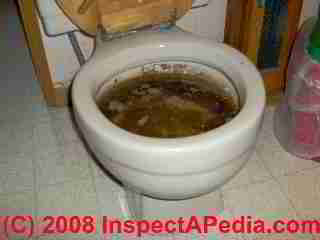 If the toilet flushes poorly, leaving waste in the bowl and if you are sure that the drain is not blocked and that the vent works, check the toilet cistern volume and toilet bowl volume.
If the toilet flushes poorly, leaving waste in the bowl and if you are sure that the drain is not blocked and that the vent works, check the toilet cistern volume and toilet bowl volume.
- The volume of water in the flush tank may be too small. When the toilet tank refills, notice where the water level is when the fill-up stops.
The level of water in the toilet tank should be within 1/4" of the "toilet tank fill line" marked inside the toilet tank.
At the highest possible toilet tank fill-up, the level of water will be just below the top of the toilet tank overflow tube in the center of the tank. - The rate of water running into the toilet tank may be too slow (some of this water slightly aids the flush), or
- The starting volume of water in the toilet bowl may have been too small.
- Check the diverter tube: Too little water in the toilet bowl to start with may be due to a lost or mis-connected fill tube that directs some water into the toilet tank standpipe (and thus into the bowl below), while the toilet tank is being re-filled. Check for that little tube.
Our photos below show the incorrect (below left) and correct (below right) connection of the toilet tank tube that sends some water into the toilet bowl while the toilet tank is filling. (These are two different toilets.)
- Check the diverter tube: Too little water in the toilet bowl to start with may be due to a lost or mis-connected fill tube that directs some water into the toilet tank standpipe (and thus into the bowl below), while the toilet tank is being re-filled. Check for that little tube.
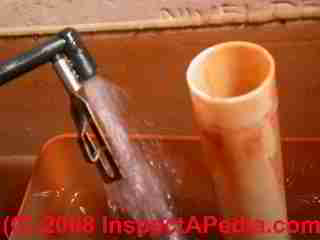
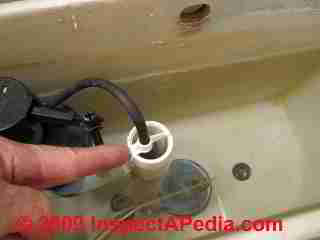
- Check the toilet cistern fill valve or float assembly adjustment: if the toilet cistern is not filling up to the indicated volume line in the toilet tank or cistern and if the diverter tube (above) is indeed properly filling the toilet bowl itself, you may need simply to adjust the position of the ball-cock float or the vertical rise distance of the toilet fill valve to put more water into the cistern.
For a toilet ball-cock float operated cistern fill valve, adjusting the float arm to raise the float will cause more water to fill the toilet tank or cistern.
For a vertical rising concentric float type fill valve (just visible at the left of our photo at above right) a sliding or screw-operated adjustment changes the position of the vertical float to increase (higher) or decrease (lower the float) the cistern fill volume.
See TOILET TYPES, CONTROLS, PARTS for a guide to identifying toilets by type, brand, parts & features.
- Check also for clogged toilet bowl rim holes: hard water or debris passing into the bowl rim from the cistern or toilet tank can partly clog the rim holes designed to wash down the toilet bowl sides in most toilets.
Clogged rim holes will slow the delivery of some of the toilet flush-water volume and can contribute to poor toilet flushing. Using a vinegar soak, lime or scale removers or even dishwasher detergent can help clean up a toilet bowl and clogged rim (along with a toothpick - Ed.)
at CONTINUE READING is a complete list of toilet trouble diagnosis and repair articles. Some toilet problems are fixed easily and right at the toilet by a simple adjustment, while others may not be the toilet's fault at all, and may need more thoughtful diagnosis and repair.
Lifting off the toilet tank top is often all you need to do to see how to fix a toilet flush problem.
Some of these simple toilet diagnosis steps require that you look into the toilet flush tank on the back of the toilet. Just lift the top off of the toilet tank and set it carefully aside on the floor where you won't break it or trip over it.
This article series TOILET REPAIR GUIDE discusses the cause, diagnosis, and repair of toilet problems (water closet problems) such as a toilet that does not flush well, clogged toilets, slow-filling toilets, running toilets, loose wobbly toilets, and odors at leaky toilets.
...
Continue reading at TOILET CLOG REPAIR, UN-BLOCK to diagnose and fix a blocked or clogged toilet or select a topic from the closely-related articles below, or see the complete ARTICLE INDEX.
Or see TOILET SLOW FLUSH FAQs - questions & answers about slow-flushing toilet problems posted originally at this page
Or see these
Recommended Articles
- BLOCKED DRAIN REPAIR
- CLOGGED DRAIN DIAGNOSIS
- PLUMBING LEAK DETECTION METHODS
- PLUMBING LEAK DETECTION & SHUTOFF DEVICES
- SEWER GAS ODORS
- TOILETS, INSPECT, INSTALL, REPAIR - home
- TOILET CLOG REPAIR, UN-BLOCK
- TOILETS, DON'T FLUSH LIST - home
- TOILET DRAIN CLOGGED
- TOILET FLUSH OPERATION
- TOILET FLUSH HANDLE LEVER REPLACEMENT
- TOILET INSTALLATION PROCEDURE
- TOILET CLOG REPAIR, UN-BLOCK
- TOILETS, DON'T FLUSH LIST
- TOILET FLUSHES POORLY
- TOILET LEAK CATASTROPHES
- TOILET OVERFLOW EMERGENCY
- TOILET PLUGS, SEWER BACKUP
- TOILET WON'T FLUSH
- TOILET TYPES, CONTROLS, PARTS - home
Suggested citation for this web page
TOILET FLUSHES POORLY at InspectApedia.com - online encyclopedia of building & environmental inspection, testing, diagnosis, repair, & problem prevention advice.
Or see this
INDEX to RELATED ARTICLES: ARTICLE INDEX to TOILET INFORMATION
Or use the SEARCH BOX found below to Ask a Question or Search InspectApedia
Ask a Question or Search InspectApedia
Try the search box just below, or if you prefer, post a question or comment in the Comments box below and we will respond promptly.
Search the InspectApedia website
Note: appearance of your Comment below may be delayed: if your comment contains an image, photograph, web link, or text that looks to the software as if it might be a web link, your posting will appear after it has been approved by a moderator. Apologies for the delay.
Only one image can be added per comment but you can post as many comments, and therefore images, as you like.
You will not receive a notification when a response to your question has been posted.
Please bookmark this page to make it easy for you to check back for our response.
IF above you see "Comment Form is loading comments..." then COMMENT BOX - countable.ca / bawkbox.com IS NOT WORKING.
In any case you are welcome to send an email directly to us at InspectApedia.com at editor@inspectApedia.com
We'll reply to you directly. Please help us help you by noting, in your email, the URL of the InspectApedia page where you wanted to comment.
Citations & References
In addition to any citations in the article above, a full list is available on request.
- Thanks to reader J.D. for discussing troubles getting a toilet to flush properly. The supposition that the toilet flushing problem was due to a defective toilet bowl, versus due to improper fill and flush control setup, was tested ad nauseam by this homeowner, her son, plumbers, and plumbing suppliers. 05/29/2010
- Pennsylvania State Fact Sheets relating to domestic wastewater treatment systems include
- Pennsylvania State Wastewater Treatment Fact Sheet SW-161, Septic System Failure: Diagnosis and Treatment
- Pennsylvania State Wastewater Treatment Fact Sheet SW-162, The Soil Media and the Percolation Test
- Pennsylvania State Wastewater Treatment Fact Sheet SW-l64, Mound Systems for Wastewater Treatment
- Pennsylvania State Wastewater Treatment Fact Sheet SW-165, Septic Tank-Soil Absorption Systems
- Document Sources used for this web page include but are not limited to: Agricultural Fact Sheet #SW-161 "Septic Tank Pumping," by Paul D. Robillard and Kelli S. Martin. Penn State College of Agriculture - Cooperative Extension, edited and annotated by Dan Friedman (Thanks: to Bob Mackey for proofreading the original source material.)
- In addition to citations & references found in this article, see the research citations given at the end of the related articles found at our suggested
CONTINUE READING or RECOMMENDED ARTICLES.
- Carson, Dunlop & Associates Ltd., 120 Carlton Street Suite 407, Toronto ON M5A 4K2. Tel: (416) 964-9415 1-800-268-7070 Email: info@carsondunlop.com. Alan Carson is a past president of ASHI, the American Society of Home Inspectors.
Thanks to Alan Carson and Bob Dunlop, for permission for InspectAPedia to use text excerpts from The HOME REFERENCE BOOK - the Encyclopedia of Homes and to use illustrations from The ILLUSTRATED HOME .
Carson Dunlop Associates provides extensive home inspection education and report writing material. In gratitude we provide links to tsome Carson Dunlop Associates products and services.


